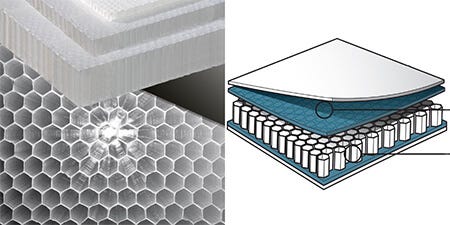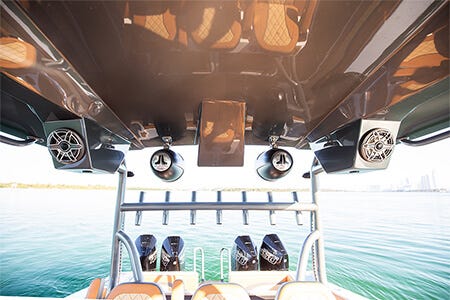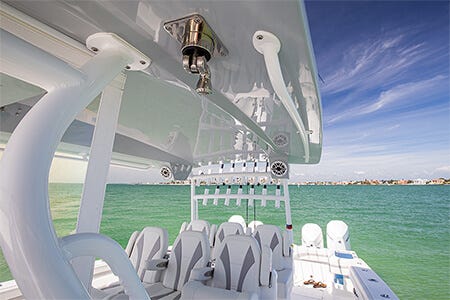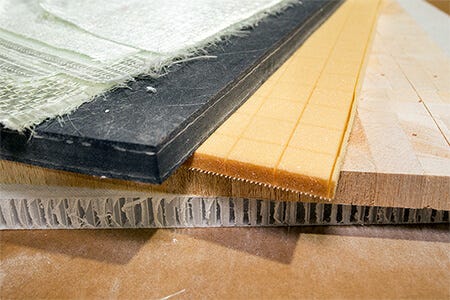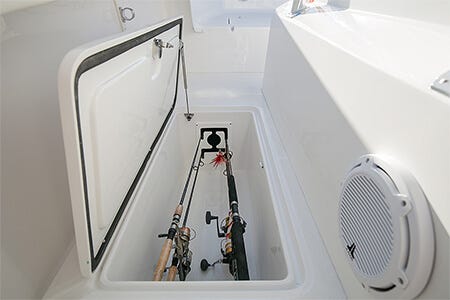What Is Nida-Core Honeycomb?
NidaCore is a coring material typically sold in 4’ x 7’ or 4’ x 8’ sheets. It is composed of a “mesh” of 8mm hexagonal “cells” made from polypropylene. The cells are covered on both sides with a non-woven polyester material that other materials can be laminated or glued to. The cells are vacuum-filled, making NidaCore very lightweight — around 10 lbs. for a 4’ x 8’ sheet of 3/4” thick (20mm) coring.
That’s similar in weight to a sheet of 3/4” closed cell foam coring like Divinycell and much lighter than a 4’ x 8’ sheet of 3/4” Coosa Bluewater 26 at 53 lbs. or 3/4” plywood at around 70 lbs. Of course, that’s by no means an apples-to-apples comparison, since Coosa and plywood are structural materials, while foam and honeycomb must be laminated between layers of fiberglass to have any strength. More on that later.
Nida-Core vs. NidaPlast
There’s some confusion surrounding various honeycomb panel products with similar names. NidaCore was originally manufactured by Florida’s NidaCore Corp, which was acquired in 2011 by 3M. 3M discontinued production of honeycomb coring soon after, but another company, Composite Essentials, purchased the business.
Today, there are several companies, including Carbon-Core and Plascore, manufacturing and marketing polypropylene honeycomb sheets, but the terms “NidaCore” and “Nida-Core” are commonly used throughout the industry to refer to honeycomb core — sort of like “Kleenex” is used to refer to facial tissues.
The terms “NidaCore” and “Nida-Core” are commonly used throughout the industry to refer to honeycomb core — sort of like “Kleenex” is used to refer to facial tissues.
Among the leading manufacturers is the French company Nidaplast, which calls its version of thermoplastic honeycomb panel “Nidaplast 8.” To further confuse things, the term “NidaPlast” is often used in the U.S. to mean a sheet of honeycomb coring with fiberglass skins pre-laminated to both sides. Nidaplast calls that product “NidaSkin.”
For the purposes of this article, since Boat Outfitters carries NidaCore, we’ll use that name, or simply “honeycomb coring,” to refer to the coring material without pre-laminated skins.
Advantages of Nida-Core and NidaPlast
Honeycomb coring has a number of advantages that make it an excellent choice for certain applications. Here are some of them.
Light Weight
As mentioned, NidaCore is very light — roughly the same weight for a given thickness as 5 lb. density closed cell foam sheeting. It is much lighter than plywood or structural composite panels like Coosa Bluewater. Of course, once the NidaCore is glassed on both sides, the weight savings are reduced significantly, but a given rigidity can still be achieved with less weight using NidaCore than those alternatives. That makes it a good choice for projects like decks and hardtops, where rigidity is critical.
Rot Resistance
The polypropylene thermoplastic that NidaCore’s cellular structure is made from is impervious to deterioration from moisture and resistant to mold and chemicals. Other composite core materials, such as closed cell foam and Coosa, are also impervious to rot, but plywood and balsa will soak up water and rot if not carefully encapsulated in fiberglass.
Sound-Absorbing and Insulating Properties
Because it is approximately 95% vacuum by volume, NidaCore is a great thermal insulator and sound absorber. Its thermal insulation properties make it well-suited for pilothouses and other superstructure, where honeycomb-cored walls and ceilings can help keep the interior cool in hot climates and warm in cold climates. Sound-absorption not only makes boats quieter when running in rough water but also can make noises like footsteps, slammed hatches or dropped equipment less audible to skittish fish — an advantage on the flats.
Because it is approximately 95% vacuum by volume, NidaCore is a great thermal insulator and sound absorber.
Low Cost
Surprisingly, NidaCore is among the less expensive core materials — usually significantly less than brand-name closed cell foam sheets of the same thickness and cheaper even than quality end-grain balsa. Note that honeycomb prelaminated with fiberglass and gelcoat skins is considerably more expensive than the core material by itself.
Weaknesses of Nida-Core and NidaPlast
Honeycomb coring is by no means the best choice for every application. It has several characteristics to be aware of that make it less than ideal for certain projects.
Lower Compression Strength
Relative to composite board or plywood coring, honeycomb coring has little inherent resistance to compression (crushing). Instead, it relies on the fiberglass skins on either side for crush-resistance; the thicker the skins, the greater the crush-resistance. That means that if you need a strong attachment to a honeycomb-cored panel, you’ll need to reinforce the area around the bolt hole to keep from crushing the laminate when you tighten the hardware.
Bolting a T-top or hardtop to a honeycomb deck, for example, would require reinforcement. So would bolting an antenna mount our outrigger bases to a honeycomb hardtop.
The most common method for reinforcing a NidaCore panel is to simply “dig out” the polypropylene cell structure around the bolt hole and then fill the void with thickened epoxy.
There are several options for reinforcing NidaCore panels. The most common is to simply “dig out” the polypropylene cell structure around the bolt hole (try using a small Allen wrench or a bent nail chucked into a drill) and then fill the void with thickened epoxy. This creates a roughly disk-shaped plug of virtually crush-proof epoxy. Another option is to add plates or disks of denser material like Coosa prior to lamination, although this requires that you pre-plan where bolts will be needed.
It should be noted that lower compression strength isn’t unique to NidaCore and other honeycomb coring materials. Other lightweight coring materials such as closed-cell foam also lack crush-resistance and should be reinforced around bolts. For applications that require extreme crush-resistance, such as transoms that have to withstand the forces of outboard mounting bolts, a denser material like Coosa is far preferable.
Poor Screw Holding
The internal honeycomb structure of NidaCore gives sheet metal screws (self-tapping screws) virtually nothing to bite into. Only the outer fiberglass skin holds screws — as well as the inner skin if you use a long enough screw to penetrate it. Reinforcing the core with an epoxy plug or a pre-installed mounting pad made of wood or Coosa — just as you would for through-bolting — solves this issue. It should be noted here too that this issue isn’t unique to honeycomb; most lightweight coring materials don’t hold screws well. Denser coring materials like plywood and Coosa are better at holding screws.
Rough Edges
Cutting NidaCore leaves a rough-looking edge where the inner honeycomb structure is exposed. Finishing it cleanly can present a challenge, since glass doesn’t bond well to the polypropylene the inner structure is made of. One option is to pack the exposed cells with some kind of structural putty, sand the putty smooth, then glass over the putty edge. Some people skip the putty and simply use a grinder to shape the edge of the NidaPlast before wrapping a strip of glass directly over it.
Packing the raw edges with putty can quickly eat up weight savings on small parts like hatch lids. That’s because the smaller the part, the larger the portion of it that is composed of putty, which is much heavier than honeycomb. On larger parts, like hardtops, the added weight of the putty has a smaller relative effect on the weight of the finished part.
Finishing the exposed edges of a honeycomb panel can present a challenge, since glass doesn’t bond well to the polypropylene the inner structure is made of.
Additionally, keep in mind that not all projects require finished edges. Decks and bulkheads, for example, of course need to be fully encapsulated, but because the edges are hidden, their appearance isn’t important.
The Best Applications for Honeycomb Coring
Add up NidaCore’s unique characteristics, and it’s easy to see where this coring material shines. NidaCore is lightweight, rigid, relatively inexpensive and a good insulator, but it also has relatively low compression strength, doesn’t hold screws well, and requires extra work to achieve clean-looking edges.
Decks, Floors and Soles
Altogether, that makes it an excellent core material for large, flat parts, especially those with hidden edges. Decks and cockpit soles, for example, are an ideal use. They need to be lightweight and rigid, their edges aren’t exposed, and there are relatively few penetrations. The location of consoles, tops, leaning posts and other equipment should be known ahead of time so reinforcement can be added before installation. NidaCore’s sound-deadening properties are also nice when it is used for decks.
Hardtops
NidaCore is also an excellent coring material for hardtops, although some extra work is required to finish the edges cleanly. Reinforcement should be added for mounting outriggers, towers, antennas, etc. and for bolting the top to the aluminum structure. As with decks, NidaCore’s exceptional rigidity and light weight are very beneficial for hardtops, which often have large unsupported spans.
Hatches
Hatches — especially large hatches — are a great application for NidaCore. Its rigidity minimizes flex underfoot, while its light weight makes large hatches easier to lift. As with hardtops, achieving cleanly finished edges will require additional steps, but the reduced cost of the coring vs. alternatives can offset that. Reinforcement should be added where latches and hinges are attached.
NidaCore’s rigidity minimizes flex underfoot, while its light weight makes large hatches easier to lift.
External and Internal Walls and Partitions
Properly laminated, NidaCore is plenty strong for use in bulkheads and walls. And because of its excellent insulating properties, it’s an especially good choice for pilot houses and other superstructures, as well as internal partitions and other structures.
A number of well-respected boat builders use honeycomb coring in their hull sides and support structures.
Other Applications
Honeycomb coring generally isn’t recommended for use in hulls, stringer grids, or similar applications. But that doesn’t mean it isn’t used successfully for those applications. In fact, a number of well-respected boat builders use honeycomb coring in their hull sides and support structures. Again, with strong laminated skins on both sides, honeycomb is very strong — and the thicker the core, the stronger the finished panel. Adding more cloth and resin for additional strength partially negates the weight savings that comes with honeycomb, but it doesn’t negate other desirable properties like sound absorption.
Pre-Finished NidaPlast
NidaCore and other honeycomb core panels must be laminated between two skins of fiberglass for strength and water resistance. You can do your own lamination of course, but another option is to purchase pre-laminated panels. For DIYers, who may not have cloth, resin and laminating tools on hand and may lack lamination expertise, pre-laminated panels can often save both money and time vs. doing your own lamination.
Pre-finished panels are available in all common Nidaplast thicknesses, including 10mm (about 3/8”), 13mm (about 1/2”), 20mm (about 3/4”) and 25mm (about 1”). The fiberglass skins add about 4mm (5/32”) to the total thickness of the panel. Skins are made of 18 oz. fiberglass and have a glossy white gelcoat finish.
Pre-finished honeycomb panels are essentially a lighter, stiffer, rot-proof alternative to plywood, making them an excellent choice for DIY fabrication projects.
Pre-finished honeycomb panels are essentially a lighter, stiffer, rot-proof alternative to plywood, making them an excellent choice for DIY fabrication projects like raised decks, consoles, livewells, pilothouses, etc. Exposed edges still have to be sealed and finished, but otherwise, the panels are ready to install. The gelcoat finish is fine by itself but the panels can also be painted and/or non-skid applied.



